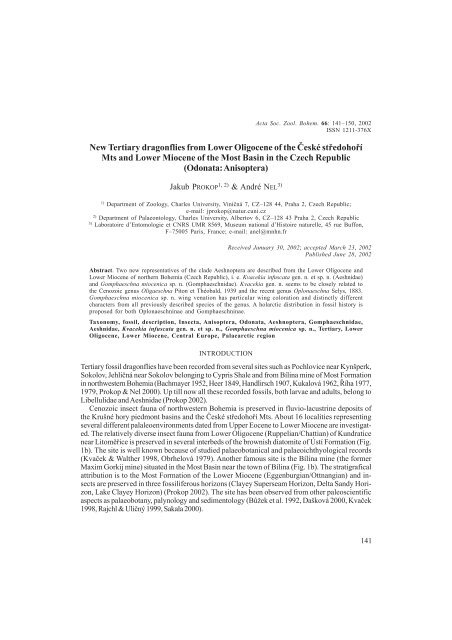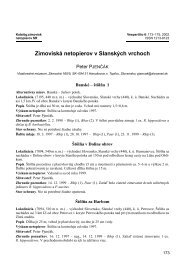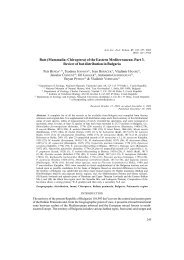Gyraulus parvus (Mollusca: Gastropoda) in the Czech Republic
Gyraulus parvus (Mollusca: Gastropoda) in the Czech Republic
Gyraulus parvus (Mollusca: Gastropoda) in the Czech Republic
- No tags were found...
You also want an ePaper? Increase the reach of your titles
YUMPU automatically turns print PDFs into web optimized ePapers that Google loves.
Acta Soc. Zool. Bohem. 66: 141–150, 2002ISSN 1211-376XNew Tertiary dragonflies from Lower Oligocene of <strong>the</strong> eské stedohoíMts and Lower Miocene of <strong>the</strong> Most Bas<strong>in</strong> <strong>in</strong> <strong>the</strong> <strong>Czech</strong> <strong>Republic</strong>(Odonata: Anisoptera)Jakub PROKOP 1, 2) & André NEL 3)1)Department of Zoology, Charles University, V<strong>in</strong><strong>in</strong>á 7, CZ–128 44, Praha 2, <strong>Czech</strong> <strong>Republic</strong>;e-mail: jprokop@natur.cuni.cz2)Department of Palaeontology, Charles University, Albertov 6, CZ–128 43 Praha 2, <strong>Czech</strong> <strong>Republic</strong>3)Laboratoire d’Entomologie et CNRS UMR 8569, Museum national d’Histoire naturelle, 45 rue Buffon,F–75005 Paris, France; e-mail: anel@mnhn.frReceived January 30, 2002; accepted March 23, 2002Published June 28, 2002Abstract. Two new representatives of <strong>the</strong> clade Aeshnoptera are described from <strong>the</strong> Lower Oligocene andLower Miocene of nor<strong>the</strong>rn Bohemia (<strong>Czech</strong> <strong>Republic</strong>), i. e. Kvacekia <strong>in</strong>fuscata gen. n. et sp. n. (Aeshnidae)and Gomphaeschna miocenica sp. n. (Gomphaeschnidae). Kvacekia gen. n. seems to be closely related to<strong>the</strong> Cenozoic genus Oligaeschna Piton et Théobald, 1939 and <strong>the</strong> recent genus Oplonaeschna Selys, 1883.Gomphaeschna miocenica sp. n. w<strong>in</strong>g venation has particular w<strong>in</strong>g coloration and dist<strong>in</strong>ctly differentcharacters from all previously described species of <strong>the</strong> genus. A holarctic distribution <strong>in</strong> fossil history isproposed for both Oplonaeschn<strong>in</strong>ae and Gomphaeschn<strong>in</strong>ae.Taxonomy, fossil, description, Insecta, Anisoptera, Odonata, Aeshnoptera, Gomphaeschnidae,Aeshnidae, Kvacekia <strong>in</strong>fuscata gen. n. et sp. n., Gomphaeschna miocenica sp. n., Tertiary, LowerOligocene, Lower Miocene, Central Europe, Palaearctic regionINTRODUCTIONTertiary fossil dragonflies have been recorded from several sites such as Pochlovice near Kynšperk,Sokolov, Jehl<strong>in</strong>á near Sokolov belong<strong>in</strong>g to Cypris Shale and from Bíl<strong>in</strong>a m<strong>in</strong>e of Most Formation<strong>in</strong> northwestern Bohemia (Bachmayer 1952, Heer 1849, Handlirsch 1907, Kukalová 1962, íha 1977,1979, Prokop & Nel 2000). Up till now all <strong>the</strong>se recorded fossils, both larvae and adults, belong toLibellulidae and Aeshnidae (Prokop 2002).Cenozoic <strong>in</strong>sect fauna of northwestern Bohemia is preserved <strong>in</strong> fluvio-lacustr<strong>in</strong>e deposits of<strong>the</strong> Krušné hory piedmont bas<strong>in</strong>s and <strong>the</strong> eské stedohoí Mts. About 16 localities represent<strong>in</strong>gseveral different palaleoenvironments dated from Upper Eocene to Lower Miocene are <strong>in</strong>vestigated.The relatively diverse <strong>in</strong>sect fauna from Lower Oligocene (Ruppelian/Chattian) of Kundraticenear Litomice is preserved <strong>in</strong> several <strong>in</strong>terbeds of <strong>the</strong> brownish diatomite of Ústí Formation (Fig.1b). The site is well known because of studied palaeobotanical and palaeoichthyological records(Kvaek & Wal<strong>the</strong>r 1998, Obrhelová 1979). Ano<strong>the</strong>r famous site is <strong>the</strong> Bíl<strong>in</strong>a m<strong>in</strong>e (<strong>the</strong> formerMaxim Gorkij m<strong>in</strong>e) situated <strong>in</strong> <strong>the</strong> Most Bas<strong>in</strong> near <strong>the</strong> town of Bíl<strong>in</strong>a (Fig. 1b). The stratigraficalattribution is to <strong>the</strong> Most Formation of <strong>the</strong> Lower Miocene (Eggenburgian/Ottnangian) and <strong>in</strong>sectsare preserved <strong>in</strong> three fossiliferous horizons (Clayey Superseam Horizon, Delta Sandy Horizon,Lake Clayey Horizon) (Prokop 2002). The site has been observed from o<strong>the</strong>r paleoscientificaspects as palaeobotany, palynology and sedimentology (Bžek et al. 1992, Dašková 2000, Kvaek1998, Rajchl & Ul<strong>in</strong>ý 1999, Sakala 2000).141








